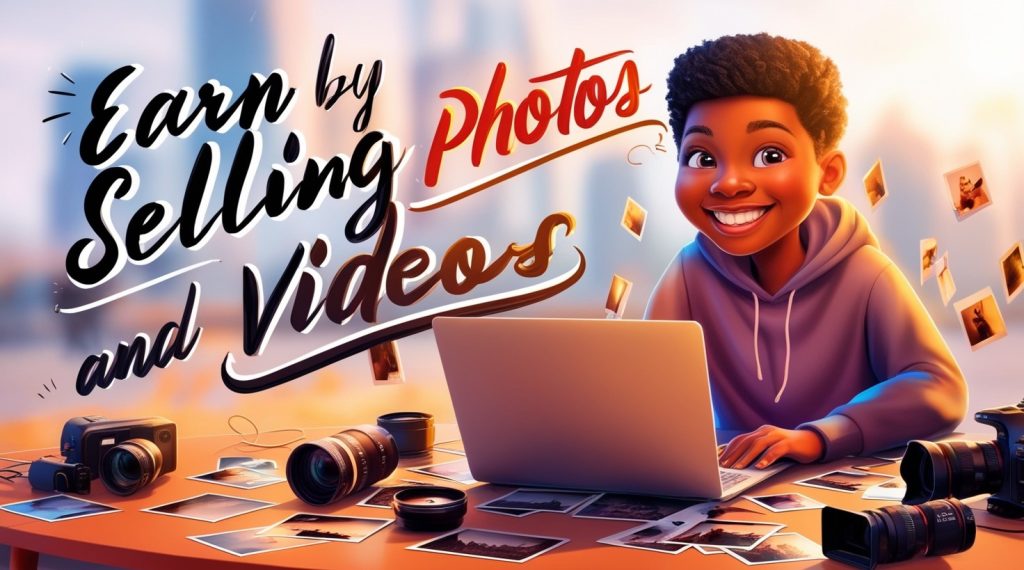Are you a passionate photographer or videographer looking to turn your hobby into a source of income? In today’s digital world, there’s a growing demand for high-quality visual content, and that creates a golden opportunity for creators like you to earn money by selling photos and videos online.

Whether you’re using a DSLR, drone, or even a high-end smartphone, your visual assets can generate steady income — even while you sleep. Here’s everything you need to know to get started.
Why Sell Photos and Videos Online?
The internet is filled with content-hungry platforms, businesses, marketers, and publishers who need eye-catching visuals every day. From travel blogs and news outlets to e-commerce brands and advertising agencies, there’s a massive market for stock photos and video footage.
Selling your media online allows you to:
- Earn passive income
- Reach a global audience
- Monetize your creative skills
- Build a portfolio that pays you over time
Best Platforms to Sell Photos and Videos
Selling on stock platforms requires more than just uploading content — you need to understand each platform’s expectations and optimize your strategy for success.
Here are some top platforms where creators can upload and sell their visual content:
1. Shutterstock
One of the largest stock marketplaces, Shutterstock offers a wide audience and rewards contributors with royalties for each download.
General Requirements:
- Account approval after submitting initial samples (photos or videos).
- Minimum resolution: 4MP for photos, 1080p for videos (4K accepted).
- Formats: JPEG (photos), MOV/MP4 (videos).
- No logos, watermarks, or copyrighted content.
- Releases are required for recognizable people or private property.
Tips for Success:
- Upload regularly to stay relevant in searches.
- Use 30–50 well-researched keywords per asset.
- Focus on in-demand topics like business, technology, and diversity.
- Check Shutterstock’s Shot List for trending content ideas.
2. Adobe Stock
Known for quality, Adobe Stock integrates directly with Creative Cloud, making it ideal for professional creators.
General Requirements:
- Free contributor account (can be accessed via Adobe ID).
- JPEG format for images (minimum 4MP); MOV/MP4 for videos.
- High quality, clean compositions.
- No intellectual property or brand names visible.
- Model/property releases when necessary.
Tips for Success:
- Adobe users can upload directly from Lightroom or Photoshop.
- Tag your media with accurate titles and keywords (Adobe uses AI to help).
- Aim for aesthetic, commercially viable content.
- Participate in Creative Briefs or Seasonal Challenges for more visibility.
3. Alamy
A favorite for photographers and videographers who want higher royalty rates. Alamy accepts both editorial and commercial content.
General Requirements:
- Submit a short test of 3 sample images for quality check.
- JPEG format for images; MP4/MOV for videos.
- No strict file size limit, but quality must be high.
- Editorial and commercial content both accepted.
- Model/property releases required for commercial use.
Tips for Success:
- Alamy allows a wide range of subjects — even niche or newsy content.
- Use all 50 keywords and include supertags (top 10 most relevant).
- Add detailed, descriptive captions.
- Consider becoming an exclusive contributor for a higher royalty rate (up to 50%).
4. Pond5
Specialized in video footage, Pond5 is perfect for filmmakers and drone users looking to sell cinematic clips.
General Requirements:
- Ideal for videos, though photos and audio are also accepted.
- Video resolution: 1080p or 4K (MP4/MOV, ProRes or H.264).
- No background music unless licensed.
- Upload in clips (5–60 seconds), cleanly edited.
- Model/property releases needed for commercial use.
Tips for Success:
- Price your content competitively (you can set your own prices).
- Use targeted keywords and compelling preview thumbnails.
- Contribute frequently to stay active in the marketplace.
- Add metadata that highlights the unique value of your footage (e.g., drone view, slow motion, time-lapse).
5. iStock by Getty Images
A highly respected brand in the stock media industry. Great for those who want to license exclusive content.
General Requirements:
- Apply through Getty’s Contributor App or GettyImages.com.
- High-quality submissions needed for approval.
- Exclusive and non-exclusive options.
- Model/property releases mandatory for commercial use.
- Video: MP4 or MOV, professional-grade quality.
Tips for Success:
- Focus on high-production-value visuals and authentic human experiences.
- Exclusivity on iStock can earn you higher royalties.
- Use Getty’s Visual Trends report to align with current market demand.
- Avoid clichés — originality is rewarded more here.
Best Practices Across All Platforms
Regardless of the platform, here are some universal practices to follow:
- Stay Organized: Maintain folders, spreadsheets, or tools to track where each file is uploaded and licensed.
- Shoot with a Purpose: Create content based on market trends, seasonality, and popular categories.
- Use Metadata Wisely: Strong titles, detailed descriptions, and relevant tags are critical for search visibility.
- Be Patient: Building a steady income takes time — focus on growing a diverse, high-quality portfolio.
- Keep Learning: Each platform has its own contributor blog or guide — read updates and stay current with industry shifts.
What Sells Well?
To maximize your earnings, focus on content that has strong commercial or editorial value. Here are some themes that consistently perform well:
- Business and technology
- Lifestyle and wellness
- Nature and travel
- Urban and drone footage
- Diversity and inclusion
- Food and hospitality
- Remote work and digital nomadism
Tips to Succeed
✅ 1. Upload Regularly
More content means more chances to be found. Build your portfolio over time with consistent uploads.
✅ 2. Use Keywords Strategically
SEO is key even in stock marketplaces. Add relevant titles, descriptions, and tags to make your content discoverable.
✅ 3. Follow Technical Guidelines
Each platform has specific requirements (file format, resolution, codec). Read them carefully to avoid rejection.
✅ 4. Get Model and Property Releases
If your content features people or private spaces, get signed releases to make them commercially viable.
✅ 5. Promote Your Work
Use social media or your personal website to showcase and link to your portfolio.
How Much Can You Earn?
Earnings depend on several factors:
- Quality and uniqueness of your content
- Volume of uploads
- Licensing type (exclusive or non-exclusive)
- Platform’s royalty percentage
Some contributors make a few hundred dollars a month, while top sellers can earn thousands monthly from their content libraries.
Final Thoughts
Selling photos and videos online is one of the best ways for creatives to generate passive income. With the right strategy, dedication, and eye for market trends, you can build a profitable side hustle — or even a full-time income — by turning your visuals into valuable digital assets.
So grab your camera, start shooting, and let your creativity pay off in 2025 and beyond.
